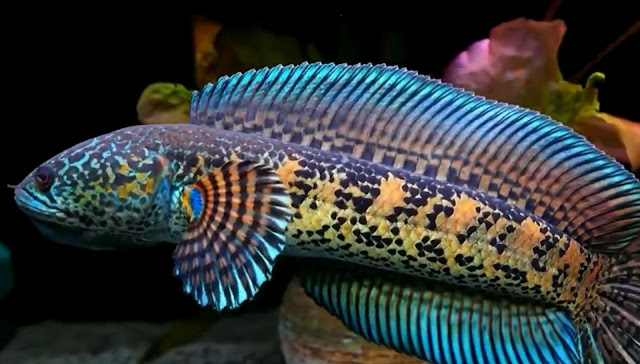Where is the Natural Habitat of Channa Aurantimaculata?
BPF- Channa Aurantimaculata, commonly referred to as the Golden Snakehead, is a captivating species of freshwater fish revered by aquatic enthusiasts worldwide. Known for its stunning appearance, vibrant orange markings, and predatory instincts, this species thrives in very specific geographical and environmental conditions. In this article, we will provide a comprehensive overview of Channa Aurantimaculata's natural habitat, examining its geographic range, environmental preferences, and the unique ecosystems it calls home.
Geographic Range of Channa Aurantimaculata
The natural habitat of Channa Aurantimaculata is primarily located in the northeastern regions of India, specifically in the state of Assam. This species is found within the Brahmaputra River Basin, a rich and diverse aquatic ecosystem that supports a variety of fish species. Assam's lush greenery, heavy rainfall, and tropical conditions create the ideal environment for this stunning predator.
Additionally, some reports indicate the presence of Channa Aurantimaculata in surrounding regions, including parts of Arunachal Pradesh. The rivers, streams, and wetlands in these areas offer the perfect combination of water temperature, flow, and prey availability for this species to flourish.
Key Environmental Conditions in Their Habitat
To understand why Channa Aurantimaculata thrives in this region, it is essential to analyze the specific environmental factors of its natural habitat:
1. Water Temperature and Quality
Channa Aurantimaculata inhabits tropical freshwater environments with water temperatures ranging between 22°C and 28°C (72°F to 82°F). These fish prefer clean, well-oxygenated water with moderate to slow currents. The Brahmaputra River Basin and its tributaries offer pristine water conditions, which are crucial for the species’ survival and reproduction.
- pH Levels: The optimal pH range for Channa Aurantimaculata is between 6.5 and 7.5.
- Water Hardness: The fish prefers slightly soft to moderate water hardness, a common feature of rivers in the northeastern Indian region.
2. Vegetative Cover and Hiding Spaces
In its natural environment, Channa Aurantimaculata is frequently found in areas with abundant aquatic vegetation and submerged logs. These hiding spots provide protection from predators and enable the species to ambush prey efficiently. Dense forests surrounding the rivers often contribute to this habitat by providing leaf litter and organic matter that enhance water quality.
3. Rainfall and Seasonal Variation
The habitat of Channa Aurantimaculata experiences heavy monsoonal rains, particularly during the months of June to September. These rains cause water levels to rise significantly, flooding nearby wetlands and creating temporary pools and streams. During this time, Channa Aurantimaculata often migrates to these flooded areas to feed and reproduce.
In the dry season, water levels recede, and the fish return to deeper sections of the rivers and streams. This seasonal variation plays a vital role in the fish's life cycle, influencing both its feeding patterns and breeding behaviors.
The Brahmaputra River Basin: A Unique Ecosystem
The Brahmaputra River Basin is one of the most ecologically diverse regions in the world. Stretching across northeastern India, the basin is characterized by:
- Large, Slow-Flowing Rivers: Ideal for Channa species that prefer calm water conditions.
- High Biodiversity: The region supports numerous aquatic species, including other predatory fish, amphibians, and crustaceans, which form a significant part of Channa Aurantimaculata’s diet.
- Lush Forests and Swamps: These provide ample cover and a rich supply of organic materials that maintain the water’s nutrient balance.
The unique combination of environmental features within the Brahmaputra Basin creates the perfect habitat for Channa Aurantimaculata.
Diet and Predatory Behavior in the Wild
In its natural habitat, Channa Aurantimaculata is a highly skilled predator. It primarily feeds on:
- Small Fish: As a carnivorous species, Channa Aurantimaculata preys on smaller fish inhabiting the same rivers and streams.
- Insects and Amphibians: Insects, frogs, and small crustaceans are common food sources, especially in the rainy season when these organisms thrive.
- Aquatic Invertebrates: The fish also consume various aquatic invertebrates, contributing to its carnivorous diet.
The dense vegetation and slow water currents in the habitat allow the species to ambush its prey stealthily, showcasing its predatory instincts.
Conservation Status and Threats to Its Habitat
Despite its beauty and resilience, the natural habitat of Channa Aurantimaculata faces significant threats:
1. Habitat Destruction
Deforestation, river pollution, and urbanization are major threats to the rivers and streams where this species resides. The destruction of aquatic vegetation and natural hiding spots disrupts the fish’s ability to hunt and breed.
2. Climate Change
Unpredictable weather patterns and rising temperatures can significantly affect water levels and quality in the Brahmaputra Basin. This disruption may alter the natural seasonal cycles critical to the survival of Channa Aurantimaculata.
3. Overfishing
The increasing demand for Channa Aurantimaculata in the aquarium trade has led to overfishing in its natural habitat. Unsustainable fishing practices pose a serious risk to the species’ population.
The Role of Conservation Efforts
Protecting the natural habitat of Channa Aurantimaculata is essential to ensure the survival of this magnificent species. Conservation efforts should focus on:
- Habitat Restoration: Reforestation and pollution control initiatives in the Brahmaputra Basin.
- Sustainable Fishing Practices: Implementing regulations to prevent overfishing and protect breeding grounds.
- Public Awareness: Educating communities about the ecological importance of this species and its habitat.
By preserving the rivers, streams, and wetlands of northeastern India, we can help safeguard the future of Channa Aurantimaculata for generations to come.
Conclusion
The natural habitat of Channa Aurantimaculata lies within the pristine rivers and wetlands of northeastern India, particularly in the Brahmaputra River Basin. Its survival depends on clean, well-oxygenated water, abundant vegetation, and seasonal monsoonal patterns. However, threats such as habitat destruction, climate change, and overfishing put this species at risk.
Efforts to protect and restore its habitat are crucial in ensuring that this captivating species continues to thrive in its natural environment. By understanding the environmental conditions that Channa Aurantimaculata requires, we can take proactive steps toward its conservation.




No comments